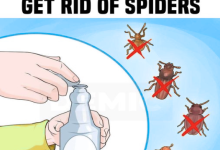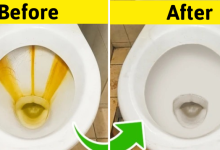
You’ve discovered mold in your home and you don’t know what to do about it. Great, you’ve come to the right place! We’ll let you know how to get rid of mold on every surface in your home in the easiest and safest way possible.
Preventing Mold With Air Purifiers
Both air purifiers and dehumidifiers are great at preventing mold in the home. Air purifiers keep your air clean and free from mold, dust, and mildew. Whereas dehumidifiers keep your air dry in humid climates.

If you want to remove dampness from your home and help prevent mold, consider getting a dehumidifier. There are plenty of small dehumidifiers that are perfect for removing dampness. Find the best small dehumidifiers here.
Note: humidifiers and dehumidifiers are both useful but are opposites. Humidifiers actually make a room more humid and are perfect for dry climates. However, they need to be cleaned regularly to prevent mold buildup.
Mold Vs. Mildew
Mold is much more harmful than mildew, but most people have no idea that there’s a difference between the two. If they do, they don’t know how to tell the difference. But it’s much easier than you may think.

Mildew is a surface fungus that looks like a patch of gray or white simply lying on the surface of a damp area. It’s easy to get rid of this seemingly harmless mildew with a little bleach (or another mildew cleaner) and a scrub brush. Mold is even more recognizable as it is black or green and usually larger and deeper than mildew. Mold is either fuzzy or slimy and spreads fast. The most easily recognizable mold is found on food, to give you an idea of what it can look like.
How To Get Rid Of Mold With DIY Methods

There are multiple ways to get rid of mold, some more effective than others. While buying a mold-remover is a great idea, and likely the most effective route, there are probably items in your home that will do the trick today!
1.Bleach
Bleach is by far the strongest and most effective over-the-counter way to get rid of mold. However, it should be diluted before being used as it is quite strong and can damage materials as well as skin.
When using bleach, make sure to wear gloves and a mask if you have one. You can never be too careful. Also, never use ble4ach without diluting it unless otherwise directed by a professional.
2. Peroxide
Peroxide is another proven method similar to bleach only much milder. It is safe to inhale and to use on the skin, so there are no ill effects connected to this useful material. Peroxide is a great way to avoid harsher chemicals.
3. Vinegar
Vinegar may not always work, but for small infestations, it may do the trick. Try it out and you can find out if it will work for you. If not, you may have to amp it up and use a chemical to get rid of the mold in your home.
If you plan on having an all-natural life in the home, vinegar is your best bet for removing mold. It not only removes stains but disinfects them as well. From dishwashers to windows, there’s not much that vinegar can’t clean.
4. Baking Soda And Borax
If all you have on hand is baking soda, you can still try to get rid of the mold in your house without buying anything else. Mix it with a little water and scrub away. If it works, great! If not, buy some bleach to take care of the stain.
How To Get Rid Of Mold On Indoor Walls
This is the most common and most dangerous type of mold. Because bleach is the strongest chemical used for getting rid of mold, it’s the best one to use for walls. Along with that, there are a few precautions to take before you begin.
A lot of times, you’ll smell this mold before you see it. This is because it will start building up behind the wall and grow until it is visible on the surface. Mold you can’t see is more dangerous because you can’t clean it!

Preparing
You’ll want to do this in the safest way possible. This means, wearing N-95 masks if you have them, goggles, gloves, and old clothes that you don’t mind tossing. You’ll also want to place a fan blowing out a window if you can.
The fan can either be cleaned thoroughly later or tossed as well. On the same note, you’ll want to turn off all other ventilation, which means AC and furnaces. Cover them and clean them when you’re’ finished.
You’ll also want to shut all doors and seal them with plastic. As long as you have your N-95, you’ll be safe. So why not keep the spores from spreading?
What Else You’ll Need
- Drywall saw
- Rubber gloves
- Safety glasses
- Scrub brush
- Pry bar
- Shop vacuum
- Utility knife
- Thick garbage bags
- Bleach
- Other heavy-duty cleaners
Opening Up the Walls
Now that you’ve prepared and gathered the materials you need in your room, you’re ready to begin. Keep your mask on and start removing baseboards. After you get baseboards removed set them aside.
If they need bleached, bleach them, or replace them. But more importantly, you need to assess the damage done to the wall. Work in sections, spraying any affected area of drywall with water. You want it damp to contain the mold and make it easier to remove.
Cut the sheetrock with a utility knife and pull it from the walls. Bag all moldy drywall and insulation and bag it up well. After it’s all removed, you can move on to the wood inside. You can even buy a drywall patch kit for small areas.
Cleaning Studs And Plywood
Create a mixture of about one quart of water and 1/2-cup bleach. Use the mixture to scrub down the exposed wood until it is gone. Do not rinse the last wash from the wood, instead, let it sit and soak.
After the area is dry, set out dehumidifiers and clean fans to help dry the area fully. Let them sit for about three days before cleaning the area again and putting up new insulation and drywall. You can then paint it again.
How To Get Rid Of Mold On Other Surfaces
While drywall is hard to work with and requires a lot of work to clean the mold off of, other surfaces can be cleaned in a day. Here’s what you need to know to clean mold from each surface in your home.
Fabric

If mold has been growing on your furniture or clothing for a long time, there’s a good chance that there is no hope in restoring it. It will need to be replaced. However, if this is new growth, it shouldn’t take much to clean it.
If possible, take the item outside. Scrub the fabric with a clean brush to remove surface stains. If you can wash it, wash it with bleach and then again without bleach. You can buy laundry bleach that is safe to use in colors.
Leather
Take the item outside and brush it with white vinegar gently. After the stain is removed, clean with specialty leather soap and warm water. After the item has dried, you will need to condition it with a leather conditioner.
Paper
Only clean dried paper and books. If the work is expensive or historical, you will want to call a professional curator to clean them for you. For all other books, use a soft paintbrush to brush away mold from each page and the cover.
You can even put wax paper between each page and lightly clean each page with peroxide. However, with all of this time and effort, it may be worth it to replace the book instead of try to salvage it.
Appliances
Clean washing machines by running an empty cycle with bleach. Clean coffee pots and washing machines by running empty cycles with vinegar. Other appliances will need to be cleaned by hand with vinegar or bleach if not around food.
Tile
Tile is actually one of the easiest surfaces to clean when mold is present. Simply clean it with diluted bleach. You may need to scrub it down, but this shouldn’t be too difficult. After it has dried, mop it up with standard tile cleaner.
Carpet
It’s not always easy to hear it, but moldy carpet needs to be removed as it cannot be cleaned good enough to ensure your family’s safety. Dampen the carpet to contain the mold and cut out the carpet in sections.
Immediately put the carpet in large trash bags and duct tape them for easy transportation and safe disposal. Take them to the dump as soon as you can.
Siding

Cleaning mold on exterior surfaces is easier than interior because it’s much safer with open ventilation. However, bleach will kill plants so cover any plants you want to be kept alive. Then, mix a gallon of bleach per one gallon of water.
Scrub down exterior surfaces and then power wash with water for best results. Powerwashing is an amazing amenity that should always be used when possible.







